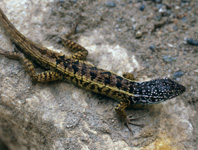Abstract
The genus Quasipaa (Family Dicroglossidae) is currently composed of 11 species distributed in China and Southeast Asia: Quasipaa acanthophora (Dubois & Ohler 2009), Q. boulengeri (Günther 1889), Q. courtoisi (Angel 1922), Q. delacouri (Angel 1928), Q. exilispinosa (Liu & Hu, 1975), Q. fasciculispina (Inger 1970), Q. jiulongensis (Huang & Liu, 1985), Q. shini (Ahl 1930), Q. spinosa (David 1875), Q. verrucospinosa (Bourret 1937), Q. yei (Chen, Qu & Jiang 2002) (Frost 2016). These species are morphologically similar, and their taxonomy is subject to controversy (Che et al. 2009). Analyses of nuclear and mitochondrial genes suggest the genus likely encompass additional cryptic species (Ye et al. 2013). Bioacoustics has contributed to studies on the taxonomy of the genus (Ye et al. 2013; Shen et al. 2015), however, to date, only the advertisement calls of Q. spinosa are known (Yu & Zheng 2009; Chen et al. 2012; Shen et al. 2015). Here, we describe the advertisement calls of Q. shini, which inhabits streams in the southern part of central China(Guizhou, Hunan, Guangxi and Jiangxi) and is characterized by the presence of keratinized skin spines on the lateral surfaces of the body.
References
Boersma, P. & Wecnink, D. (2006) Praat version 4.2.23. Avaliable from: www.praat.org (Accessed 2 Dec. 2016)
Che, J., Hu, J., Zhou, W., Murphy, R.W., Papenfuss, T.J., Chen, M., Rao, D., Li, P. & Zhang, Y. (2009) Phylogeny of the Asian spiny frog tribe Paini (Family Dicroglossidae) sensu Dubois. Molecular Phylogenetics and Evolution, 50 (2009), 59–73.
http://dx.doi.org/10.1016/j.ympev.2008.10.007Chen, P., Zheng, R.Q., Huang, H., Yu, X.Y. & Xu, Z.W. (2012) Mating call of Paa spinosa is related to temperture but not to body size. Sichuan Journal of Zoology, 31 (4), 513–517.
Frost, D.R. (2016) "Quasipaa Dubois, 1992". Amphibian Species of the World 6.0, an Online Reference. American Museum of Natural History.
Pröhl, H. (2003) Variation in male calling behaviour and relation to male mating success in the Strawberry Poison Frog (Dendrobates pumilio). Ethology, 109, 273—290.
Shen, B., Chen, P., Zheng, R.Q., Min, J.J., Dong, B.J. & Zhao, M.M. (2015) Geographic variation in the advertisement calls of the giant spiny frog (Paa spinosa). Acta Ecologica Sinica, 35, 39–45.
http://dx.doi.org/10.1016/j.chnaes.2015.01.001
Xu, J., Xie, F., Jiang, J., Mo Y. & Zheng, Z. (2005) The acoustic features of the mating call of 12 anuran species. Chinese Journal of Zoology, 40, 12–19.
http://dx.doi.org/10. 13859/ j . cjz. 2005. 03. 003
Yu, B.G. & Zheng, R.Q. (2009) The advertisement call of the giant spiny frog Paa spinosa. Current Zoology, 55, 411–415.
Ye, S., Huang, H., Zheng, R., Zhang, J., Yang, G. & Xu, S. (2013) Phylogeographic analyses strongly suggest cryptic speciation in the giant spiny frog (Dicroglossidae: Paa spinosa) and interspecies hybridization in Paa. PLoS One, 8, e70403.
http://dx.doi.org/10.1371/journal.pone.0070403

